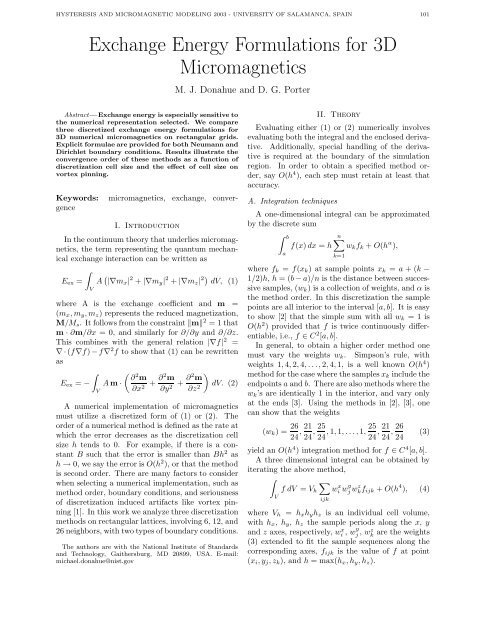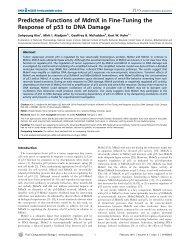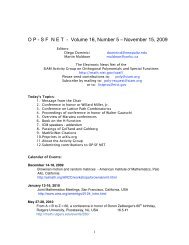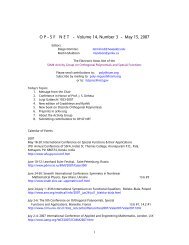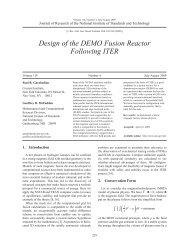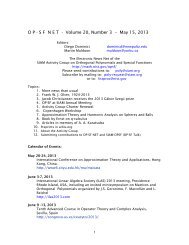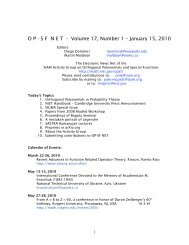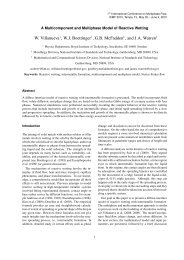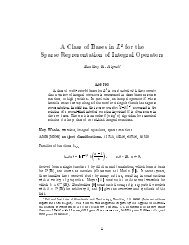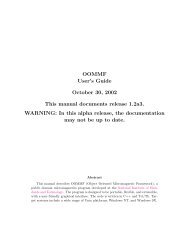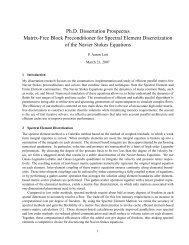Exchange Energy Formulations for 3D Micromagnetics
Exchange Energy Formulations for 3D Micromagnetics
Exchange Energy Formulations for 3D Micromagnetics
Create successful ePaper yourself
Turn your PDF publications into a flip-book with our unique Google optimized e-Paper software.
HYSTERESIS AND MICROMAGNETIC MODELING 2003 - UNIVERSITY OF SALAMANCA, SPAIN 101<br />
<strong>Exchange</strong> <strong>Energy</strong> <strong>Formulations</strong> <strong>for</strong> <strong>3D</strong><br />
<strong>Micromagnetics</strong><br />
Abstract—<strong>Exchange</strong> energy is especially sensitive to<br />
the numerical representation selected. We compare<br />
three discretized exchange energy <strong>for</strong>mulations <strong>for</strong><br />
<strong>3D</strong> numerical micromagnetics on rectangular grids.<br />
Explicit <strong>for</strong>mulae are provided <strong>for</strong> both Neumann and<br />
Dirichlet boundary conditions. Results illustrate the<br />
convergence order of these methods as a function of<br />
discretization cell size and the effect of cell size on<br />
vortex pinning.<br />
Keywords: micromagnetics, exchange, convergence<br />
I. Introduction<br />
In the continuum theory that underlies micromagnetics,<br />
the term representing the quantum mechanical<br />
exchange interaction can be written as<br />
<br />
Eex = A |∇mx| 2 + |∇my| 2 + |∇mz| 2 dV, (1)<br />
V<br />
where A is the exchange coefficient and m =<br />
(mx,my,mz) represents the reduced magnetization,<br />
M/Ms. It follows from the constraint m2 =1that<br />
m · ∂m/∂x = 0, and similarly <strong>for</strong> ∂/∂y and ∂/∂z.<br />
This combines with the general relation |∇f| 2 =<br />
∇·(f∇f) − f∇2f to show that (1) can be rewritten<br />
as<br />
2 ∂ m<br />
Eex = − A m ·<br />
∂x2 + ∂2m ∂y2 + ∂2m ∂z2 <br />
dV. (2)<br />
V<br />
A numerical implementation of micromagnetics<br />
must utilize a discretized <strong>for</strong>m of (1) or (2). The<br />
order of a numerical method is defined as the rate at<br />
which the error decreases as the discretization cell<br />
size h tends to 0. For example, if there is a constant<br />
B such that the error is smaller than Bh 2 as<br />
h → 0, we say the error is O(h 2 ), or that the method<br />
is second order. There are many factors to consider<br />
when selecting a numerical implementation, such as<br />
method order, boundary conditions, and seriousness<br />
of discretization induced artifacts like vortex pinning<br />
[1]. In this work we analyze three discretization<br />
methods on rectangular lattices, involving 6, 12, and<br />
26 neighbors, with two types of boundary conditions.<br />
The authors are with the National Institute of Standards<br />
and Technology, Gaithersburg, MD 20899, USA. E-mail:<br />
michael.donahue@nist.gov<br />
M. J. Donahue and D. G. Porter<br />
II. Theory<br />
Evaluating either (1) or (2) numerically involves<br />
evaluating both the integral and the enclosed derivative.<br />
Additionally, special handling of the derivative<br />
is required at the boundary of the simulation<br />
region. In order to obtain a specified method order,<br />
say O(h4 ), each step must retain at least that<br />
accuracy.<br />
A. Integration techniques<br />
A one-dimensional integral can be approximated<br />
by the discrete sum<br />
b<br />
n<br />
f(x) dx = h wkfk + O(h α ),<br />
a<br />
k=1<br />
where fk = f(xk) at sample points xk = a +(k −<br />
1/2)h, h =(b − a)/n is the distance between successive<br />
samples, (wk) is a collection of weights, and α is<br />
the method order. In this discretization the sample<br />
points are all interior to the interval [a, b]. It is easy<br />
to show [2] that the simple sum with all wk =1is<br />
O(h 2 ) provided that f is twice continuously differentiable,<br />
i.e., f ∈ C 2 [a, b].<br />
In general, to obtain a higher order method one<br />
must vary the weights wk. Simpson’s rule, with<br />
weights 1, 4, 2, 4,...,2, 4, 1, is a well known O(h 4 )<br />
method <strong>for</strong> the case where the samples xk include the<br />
endpoints a and b. There are also methods where the<br />
wk’s are identically 1 in the interior, and vary only<br />
at the ends [3]. Using the methods in [2], [3], one<br />
can show that the weights<br />
(wk) = 26<br />
24<br />
, 21<br />
24<br />
, 25<br />
24<br />
, 1, 1,...,1, 25<br />
24<br />
21 26<br />
, ,<br />
24 24<br />
(3)<br />
yield an O(h4 ) integration method <strong>for</strong> f ∈ C4 [a, b].<br />
A three dimensional integral can be obtained by<br />
iterating the above method,<br />
<br />
<br />
fdV = Vh<br />
V<br />
w<br />
ijk<br />
x i wy j wz kfijk + O(h 4 ), (4)<br />
where Vh = hxhyhz is an individual cell volume,<br />
with hx, hy, hz the sample periods along the x, y<br />
and z axes, respectively, wx i , wy j , wz k are the weights<br />
(3) extended to fit the sample sequences along the<br />
corresponding axes, fijk is the value of f at point<br />
(xi,yj,zk), and h =max(hx,hy,hz).
102 HYSTERESIS AND MICROMAGNETIC MODELING 2003 - UNIVERSITY OF SALAMANCA, SPAIN<br />
B. 6- and 12-neighbor methods<br />
If we consider one term in (2), say<br />
<br />
Φ=− A m ·<br />
V<br />
∂2m dV, (5)<br />
∂x2 then Φ can be represented numerically as<br />
<br />
Φd = −Vh<br />
Aijkw x i dii ′mijk · mi ′ jk, (6)<br />
jk<br />
w y<br />
j wz k<br />
ii ′<br />
where (dii ′) is a discrete representation <strong>for</strong> the operator<br />
∂2 /∂x2 .<br />
The most common representation <strong>for</strong> the exchange<br />
energy involves a three term approximation to the<br />
second derivative in (5), namely<br />
f ′′ (xk) = 1<br />
h2 (fk−1 − 2fk + fk+1)+O(h 2 ), (7)<br />
<strong>for</strong> f ∈ C4 [xk − h, xk + h]. This expression involves<br />
the center point xk and its two nearest neighbors.<br />
Including the ∂2 /∂y2 and ∂2 /∂z2 terms expands the<br />
sum to three dimensions, and triples the neighbor<br />
count. Hence we call this the ‘six neighbor method.’<br />
At any point x where f ∈ C4 [x − h, x + h], and in<br />
particular at the boundaries of the simulation region<br />
(outside of which we assume m = 0), the relation<br />
(7) cannot be used. We consider explicitly the case<br />
x = x1 near the boundary x = a, but the general<br />
case is completely analogous.<br />
Considering first the case with Neumann boundary<br />
conditions, where f ′ (a) is given, Taylor series<br />
expansions about x1 <strong>for</strong> f and f ′ yield<br />
f ′′ (x1) = f2 − f1 − hf ′ (a)<br />
h2 + O(h). (8)<br />
At equilibrium, in the absence of surface anisotropy<br />
or other boundary fields, the normal derivative of the<br />
magnetization at the boundary satisfies ∂m/∂ˆn =0<br />
[4], which here means f ′ (a) =0.<br />
Compared to (7), the accuracy in (8) is O(h) instead<br />
of O(h2 ). The symmetry of the samples about<br />
xk in (7) results in cancellation of the (x−xk) 3 terms<br />
in the Taylor expansion, which does not happen<br />
here. However, regardless of the number of samples<br />
n, there is only one edge term near x = a where (8) is<br />
applied, and this term will be multiplied by the sample<br />
length h during the integration process. Thus the<br />
approximation in toto is O(h2 ). The approximation<br />
error in the interior, using (7), is O(h3 ) locally when<br />
considered part of the integration process, but the<br />
number of such terms is n − 2 ≈ (b − a)/h, sothe<br />
total approximation error in the interior is O(h2 ).<br />
For Dirichlet boundary conditions, f(a) is specified<br />
instead of f ′ (a). Working as be<strong>for</strong>e, we obtain<br />
f ′′ (x1) = 4f2 − 12f1 +8f(a)<br />
3h2 + O(h). (9)<br />
The 8f(a)/(3h 2 ) term can be treated as an applied<br />
field concentrated in the x1 discretization cell.<br />
We can proceed similarly <strong>for</strong> an O(h 4 ) method. A<br />
sixth order Taylor series expansion shows [5]<br />
f ′′ (xk) = −fk−2 +16fk−1 − 30fk +16fk+1 − fk+2<br />
12h 2<br />
+O(h 4 ), (10)<br />
<strong>for</strong> f ∈ C 6 [xk − 2h, xk +2h]. Expanding to three<br />
dimensions requires 12 neighboring samples of f, so<br />
we call this the ‘12-neighbor method.’ Although less<br />
common than the 6-neighbor approach, this method<br />
has been considered be<strong>for</strong>e [6], [7], [8]. In this<br />
work we supply additional details and some new approaches<br />
to handling the boundary conditions.<br />
The sampling requirements imply that (10) cannot<br />
be applied within two cells of a boundary. For<br />
Neumann boundary conditions, we find<br />
f ′′ (x1) = −59f1 +64f2− 5f3 − 32hf ′ (a)<br />
38h2 − 11f ′ (x1)<br />
19h + O(h3 ). (11)<br />
Analogous to the 6-neighbor setting, O(h3 ) accuracy<br />
here suffices to yield a fourth order method overall.<br />
The f ′ (x1) quantity in (11) is an unknown value.<br />
However, f represents one component of m in (5),<br />
and m · ∂m/∂x = 0 at all points because of the<br />
constraint m = 1. Thus, in (5) we can use<br />
m · ∂ 2 m/∂x 2 x1<br />
= m1 · −59m1 +64m2 − 5m3<br />
38h 2<br />
− 16<br />
19h 2 ∂m/∂ˆn| a + O(h3 ),<br />
where typically ∂m/∂ˆn| a = 0. An alternative to using<br />
f ′ (x1) in (11) is to include an additional sample<br />
of f, sayf(x4).<br />
At cell x2 we find<br />
f ′′ (x2) = 335f1 − 669f2 + 357f3 − 23f4<br />
264h2 + 1<br />
11h f ′ (a)+O(h 3 ), (12)<br />
which makes explicit use of f ′ (a). Solving <strong>for</strong><br />
f ′ (x2)/h and adding the result to (12) yields<br />
f ′′ (x2) = 4f1 − 15f2 +12f3 − f4<br />
6h 2<br />
− 1<br />
h f ′ (x2)+O(h 3 ). (13)<br />
As be<strong>for</strong>e, the f ′ (x2) term can be dropped when<br />
considering the total integrand. Either (12) or (13)<br />
may be used to estimate f ′′ (x2). In the simulation<br />
results below we used (12).
and<br />
For Dirichlet boundary conditions,<br />
f ′′ (x1) = −165f1 +40f2 − 3f3 + 128f(a)<br />
30h 2<br />
+ 1<br />
h f ′ (x1)+O(h 3 ) (14)<br />
f ′′ (x2) = 175f1 − 280f2 + 147f3 − 10f4 − 32f(a)<br />
105h 2<br />
+O(h 3 ), (15)<br />
The f ′ (x1) term in the first equation can be ignored.<br />
The f(a) terms can be treated as an applied fields.<br />
In place of (15), one can use the relation (13), which<br />
is more convenient because then an applied field<br />
term arising from f(a) is not required at x2.<br />
In a practical energy minimization scheme, e.g.,<br />
conjugate-gradient, the energy is differentiated with<br />
respect to the discretized magnetization. From (6),<br />
where<br />
∂Φd<br />
∂mijk<br />
<br />
= −2Vh<br />
jk<br />
w y<br />
j wz k<br />
<br />
ii ′<br />
cii ′ jkmi ′ jk, (16)<br />
cii ′ jk = 1<br />
2 (Aijkw x i dii ′ + Ai ′ jkw x i ′di ′ i) . (17)<br />
Here cii ′ jk is a symmetric bilinear <strong>for</strong>m in i and i ′ .It<br />
is a general property of bilinear <strong>for</strong>ms that m T Bm =<br />
m T (B + B T )m/2, so (6) can be rewritten as<br />
<br />
Φd = −Vh<br />
jk<br />
w y<br />
j wz k<br />
<br />
ii ′<br />
cii ′ jkmijk · mi ′ jk. (18)<br />
In the remainder of this section we consider the<br />
case where A is constant. If we factor A out of the<br />
integral (2), so cii ′ jk = cii ′, we can rewrite the inner<br />
sum in (18) as mT Cm, whereC =(cii ′). The norm<br />
constraint, m = 1, implies that any modifications<br />
along the diagonal of the matrix C only change the<br />
computed energy by a constant offset. Since we are<br />
interested in energy differences and minima, such<br />
a change is not significant; moreover, adjusting the<br />
diagonal values so the rows sum to zero yields better<br />
numerics because there is less roundoff error when<br />
the neighbor-to-neighbor magnetization variation is<br />
small [9].<br />
For the 6-neighbor method with Neumann boundary,<br />
the C resulting from (11) automatically satisfies<br />
these conditions. However, <strong>for</strong> Dirichlet boundary<br />
conditions the matrix arising from (9) is asymmetric;<br />
making the above adjustments yields<br />
⎡<br />
⎤<br />
−7/6 7/6<br />
⎢ 7/6 −13/6 1<br />
⎥<br />
C = ⎢<br />
⎣<br />
1 −2 1 ⎥ , (19)<br />
⎦<br />
. ..<br />
103<br />
where the bottom right hand corner of the matrix is<br />
symmetric about the cross diagonal with the upper<br />
left hand corner, i.e., the matrix is centro-symmetric<br />
[10]. There is in addition an effective boundary cell<br />
applied field, from (9).<br />
For the 12-neighbor methods, the boundary corrections,<br />
including the w x i terms <strong>for</strong> the O(h4 ) integration<br />
method (3), affect the first 5 rows of C.<br />
Table I presents the coefficients of C. These are<br />
pentadiagonal matrices; non-zero entries are found<br />
by symmetry of the entries in this table about either<br />
diagonal, or otherwise from the general interior <strong>for</strong>mulae<br />
ck,k = −5/2, ck,k±1 =4/3, ck,k±2 = −1/12.<br />
In addition to convergence as a function of h, one<br />
can also look at the number of iterates of an energy<br />
minimization method, say conjugate-gradient,<br />
needed to converge <strong>for</strong> a fixed h. We call this ‘iterative<br />
convergence.’ To a large extent, the iterative<br />
convergence can be predicted from an eigenvalue<br />
analysis of C. We computed numerically the<br />
eigenvalues of −C <strong>for</strong> modest sizes (up to n = 19),<br />
and found them to lie in the range [0, 4) <strong>for</strong> the 6neighbor<br />
methods, and inside [0, 16/3) <strong>for</strong> the 12neighbor<br />
methods. The 0 eigenvalue corresponds to<br />
the uni<strong>for</strong>mly magnetized state, which is minimal<br />
exchange energy. The upper limit corresponds to a<br />
bulk +1, -1, +1, ...alternating state, which is maximal<br />
exchange energy. In practice we found all of<br />
the exchange energy <strong>for</strong>mulations considered above<br />
to have similar iterative convergence behavior.<br />
C. 26-neighbor exchange energy<br />
The third approach uses exchange energy representation<br />
(1) instead of (2). The magnetization<br />
between the discretization points is approximated<br />
using a trilinear interpolation of nearby grid points,<br />
with basis functions {1,x,y,z,xy,xz,yz,xyz}.<br />
Given this piecewise polynomial representation <strong>for</strong><br />
m(x, y, z), and assuming constant A, <strong>for</strong>mula (1)<br />
can be computed analytically. Similar methods<br />
are employed in finite-element micromagnetics [11],<br />
[12].<br />
The total exchange energy is found to be<br />
AVh<br />
36<br />
<br />
ijk i ′ j ′ k ′<br />
cijki ′ j ′ k ′(mijk − mi ′ j ′ k ′) · mijk (20)<br />
where the coefficients cijki ′ j ′ k ′ are specified in Ta-<br />
ble II. There are 26 non-zero terms, so this is a<br />
‘26-neighbor’ method. Cells mi ′ j ′ k ′ outside the simulation<br />
volume are handled by reflecting m across<br />
the boundary, which is equivalent to specifying<br />
∂m/∂ˆn = 0 at the boundary. This an O(h 2 )<br />
method. We have not considered Dirichlet boundary<br />
conditions <strong>for</strong> this method.
104 HYSTERESIS AND MICROMAGNETIC MODELING 2003 - UNIVERSITY OF SALAMANCA, SPAIN<br />
For cubic cells, hx = hy = hz = h, andtheabove<br />
expressions <strong>for</strong> the coefficients cijki ′ j ′ k ′ simplify to<br />
cijkījk = cijki¯jk = cijkijk ¯ =0,cijkī¯jk = cijkīj¯ k =<br />
cijki¯j ¯ k =6/h2 ,andcijkī¯j ¯ k =3/h2 . If additionally we<br />
assume there is no variation in m along the z-axis,<br />
then we obtain the two-dimensional ‘8-neighbor dot<br />
product’ studied previously [1].<br />
III. Simulation Results<br />
The exchange energy <strong>for</strong>mulations described<br />
above were implemented within the OOMMF micromagnetic<br />
package [13], which was used to produce<br />
the following results.<br />
We first compared the exchange representations<br />
<strong>for</strong> a head-to-head transverse wall in a thin film<br />
strip. Only exchange and anisotropy energies were<br />
included. The magnetization was held in the film<br />
plane by a strong easy-plane anisotropy, and the wall<br />
center was pinned by a uniaxial anisotropy directed<br />
along the strip axis, with spatially varying Ku of the<br />
<strong>for</strong>m r 2 /(1+r 2 ), where r is the distance from the center<br />
of the strip. In order to get O(h 4 ) convergence<br />
in the anisotropy calculation, we used the integration<br />
weights from (3) to compute the anisotropy energy.<br />
Using Neumann ∂m/∂ˆn = 0 boundary conditions,<br />
the 6- and 26-neighbor methods showed O(h 2 )<br />
convergence, while the 12-neighbor method obtained<br />
O(h 4 ) convergence, as expected.<br />
Fig. 1 compares convergence of the 6- and 12neighbor<br />
methods on two turns of a uni<strong>for</strong>m 1D magnetization<br />
spiral. Here γ is the (uni<strong>for</strong>m) angle between<br />
adjacent mk; γ = 720 ◦ /n. When the proper<br />
Dirichlet boundary conditions are applied, the convergence<br />
rates are second and fourth order, respectively.<br />
However, since the ends of the spiral are held<br />
fixed, ∂m/∂ˆn = 0. The consequence of applying incorrect<br />
boundary conditions is seen in the top two<br />
curves—the convergence drops to first order. For<br />
this 1D simulation, the 6- and 26-neighbor methods<br />
are equivalent.<br />
µMAG Standard Problem No. 3 [14] is studied<br />
in Fig. 2. In this <strong>3D</strong> problem, the equilibrium<br />
configurations of a cube with easy-axis anisotropy<br />
Ku directed along a cube principal axis are calculated.<br />
The case we considered was a vortex magnetization<br />
configuration with cube edge length L set<br />
to 8.5 lex, wherelex is the magnetostatic exchange<br />
length 2A/(µ0M 2 s ). We found the reduced to-<br />
tal energy density in the equilibrium state to be<br />
0.3015 × µ0M 2 s /2, which is comparable to values reported<br />
by other researchers [14]. Unlike the other<br />
examples, this problem includes self-magnetostatic<br />
energy. Since our implementation does not include<br />
an O(h4 ) representation <strong>for</strong> self-magnetostatic energy,<br />
it is not surprising that the convergence rates<br />
are second order. Even so, <strong>for</strong> a given cell size h,<br />
the error from the 12-neighbor method is almost<br />
half that from the 6-neighbor method. We also per<strong>for</strong>med<br />
tests where the magnetization was subsampled<br />
from the equilibrium configuration of the finest<br />
discretization. In that case, with the magnetization<br />
held fixed, the 12-neighbor method attains O(h4 )<br />
convergence as the subsampling rate is varied.<br />
It is also important to consider discretization induced<br />
effects on magnetization structures [1], [15].<br />
Fig. 3 examines the effects of cell size on vortex motion.<br />
In this study, a vortex configuration is centered<br />
in a thin film 132 nm square element, with Py material<br />
properties (A =13pJ/m,Ms = 800 kA/m).<br />
Self-magnetostatic energy is simulated with a strong<br />
easy-plane uniaxial anisotropy, Ku = µ0M 2 s<br />
. This is<br />
an unstable configuration in the continuum setting;<br />
the slightest in-plane applied field suffices to push<br />
the vortex core away from the center position. In<br />
practice, however, divots in the energy surface produced<br />
by the discretization pin the vortex in place.<br />
One measure of this effect is the field, Hpin, required<br />
to unpin the vortex. As seen in Fig. 3, the 26neighbor<br />
method has significantly smaller Hpin <strong>for</strong><br />
h>lex, but otherwise the 12-neighbor method dominates.<br />
We also tested Néel wall collapse [15], and found<br />
that the 12-neighbor method to be somewhat more<br />
resistant to this discretization artifact than the 6- or<br />
26-neighbor methods.<br />
IV. Conclusions<br />
We have examined 3 <strong>for</strong>mulations <strong>for</strong> exchange energy,<br />
with general Neumann and Dirichlet boundary<br />
conditions. As a function of the discretization cell<br />
size h, the error <strong>for</strong> the 6- and 26-neighbor methods<br />
is O(h 2 ), while <strong>for</strong> the 12-neighbor it is O(h 4 ).<br />
When considering the convergence of equilibrium<br />
states, the rate is limited by the slowest convergence<br />
among all the energy terms. Even in this case the 12neighbor<br />
method can yield significantly smaller errors.<br />
Our tests of discretization induced vortex pinning<br />
find the 26-neighbor method has the smallest<br />
pinning field <strong>for</strong> h larger than the exchange length,<br />
but otherwise the 12-neighbor method is preferable.<br />
References<br />
[1] M.J. Donahue, R.D. McMichael, Physica B 233 (1997)<br />
272.<br />
[2] P.J. Davis, P. Rabinowitz, Methods of Numerical Integration,<br />
Academic Press, Orlando, 1984.<br />
[3] J. Stoer, R. Bulirsch, Introduction to Numerical Analysis,<br />
Springer-Verlag, New York, 1993.<br />
[4] W.F. Brown, Jr., <strong>Micromagnetics</strong>, Wiley Interscience,<br />
New York, 1963.<br />
[5] M. Abramowitz, I.A. Stegun (Eds.), Handbook of Mathematical<br />
Functions, U.S. NBS, Washington D.C., 1970.
cij Neumann Dirichlet<br />
c11 -325703/240768 -2639/2880<br />
c12 39257/26752 73/72<br />
c13 -1255/10944 -281/2880<br />
c22 -643747/240768 -79/32<br />
c23 16297/12672 113/72<br />
c24 -337/4224 -11/96<br />
c33 -196421/80256 -1319/480<br />
c34 49/36 49/36<br />
c35 -49/576 -49/576<br />
c44 -32077/12672 -719/288<br />
c55 -1439/576 -1439/576<br />
TABLE I<br />
Corner coefficients <strong>for</strong> O(h4 ) interaction matrices,<br />
<strong>for</strong> ∂m/∂ˆn =0Neumann and Dirichlet boundary<br />
conditions with constant exchange coefficient A.<br />
c ijkījk<br />
c ijki¯jk<br />
c ijkij ¯ k<br />
c ijkī¯jk<br />
c ijkīj ¯ k<br />
c ijki¯j ¯ k<br />
c ijkī¯j ¯ k<br />
16<br />
h2 −<br />
x<br />
8<br />
h2 −<br />
y<br />
8<br />
h2 z<br />
− 8<br />
h2 +<br />
x<br />
16<br />
h2 −<br />
y<br />
8<br />
h2 z<br />
− 8<br />
h2 −<br />
x<br />
8<br />
h2 +<br />
y<br />
16<br />
h2 z<br />
4<br />
h2 +<br />
x<br />
4<br />
h2 −<br />
y<br />
2<br />
h2 z<br />
4<br />
h2 −<br />
x<br />
2<br />
h2 +<br />
y<br />
4<br />
h2 z<br />
2 − h2 +<br />
x<br />
4<br />
h2 +<br />
y<br />
4<br />
h2 z<br />
1<br />
h2 +<br />
x<br />
1<br />
h2 +<br />
y<br />
1<br />
h2 z<br />
TABLE II<br />
Coefficients <strong>for</strong> the 26-neighbor exchange energy<br />
<strong>for</strong>mulation, Eq. (20). Here ī = i ± 1, ¯j = j ± 1,<br />
¯k = i ± 1, and cijki ′ j ′ k ′ =0otherwise.<br />
[6] P. Trouilloud, J. Miltat, J. Magn. Magn. Mater. 66 (1987)<br />
194.<br />
[7] D.V. Berkov, K. Ramstöck, A. Hubert, Phys. Stat. Sol.<br />
(a) 137 (1993) 207.<br />
[8] M. Labrune, J. Miltat, J. Magn. Magn. Mater. 151 (1995)<br />
231.<br />
[9] M.J. Donahue, D.G. Porter, R.D. McMichael, J. Eicke, J.<br />
Appl. Phys. 87 (2000) 5520.<br />
[10] J.M. Marin, T. Dhorne, Statistics 37 (2003) 85.<br />
[11] W.J. Chen, D.R. Fredkin, and T.R. Koehler, IEEE<br />
Trans. Magn. 29 (1993) 2124.<br />
[12] J. Fidler, T. Schrefl, J. Phys. D: Appl. Phys. 33 (2000)<br />
R135.<br />
[13] M.J. Donahue, D.G. Porter, OOMMF User’s Guide,<br />
NISTIR 6376, NIST, Gaithersburg, MD, 1999.<br />
[14] R.D. McMichael, M.J. Donahue,<br />
.<br />
[15] M.J. Donahue, J. Appl. Phys. 83 (1998) 6491.<br />
Relative energy error<br />
10 0<br />
10 -4<br />
10 -8<br />
10 -12<br />
10 -16<br />
6-ngbr, dm/dn = 0<br />
12-ngbr, dm/dn = 0<br />
6-ngbr, Dirichlet<br />
12-ngbr, Dirichlet<br />
105<br />
0.1 1 10 100<br />
Neighbor spin angle γ (deg)<br />
Fig. 1. <strong>Exchange</strong> energy error <strong>for</strong> a two period uni<strong>for</strong>m magnetization<br />
spiral. The fitted lines are, top to bottom, 10 −3 γ,<br />
3 × 10 −5 γ 2 ,and10 −9 γ 4 .<br />
Relative energy error<br />
10 -2<br />
10 -3<br />
10 -4<br />
26-ngbr<br />
6-ngbr<br />
12-ngbr<br />
0.25 0.5<br />
Cell size/exchange length<br />
1<br />
Fig. 2. Total energy error <strong>for</strong> µMAG Standard Problem<br />
No. 3. The fitted lines are, top to bottom, 0.02∆ 2 ,0.01∆ 2 ,<br />
and 5.5 × 10 −3 ∆ 2 ,where∆=h/lex.<br />
μ 0 H pin (mT)<br />
16<br />
14<br />
12<br />
10<br />
8<br />
6<br />
4<br />
2<br />
0<br />
1 2 3 4<br />
Cell size/exchange length<br />
26-ngbr<br />
6-ngbr<br />
12-ngbr<br />
Fig. 3. Applied field required to unpin a vortex as a function<br />
of discretization cell size.


